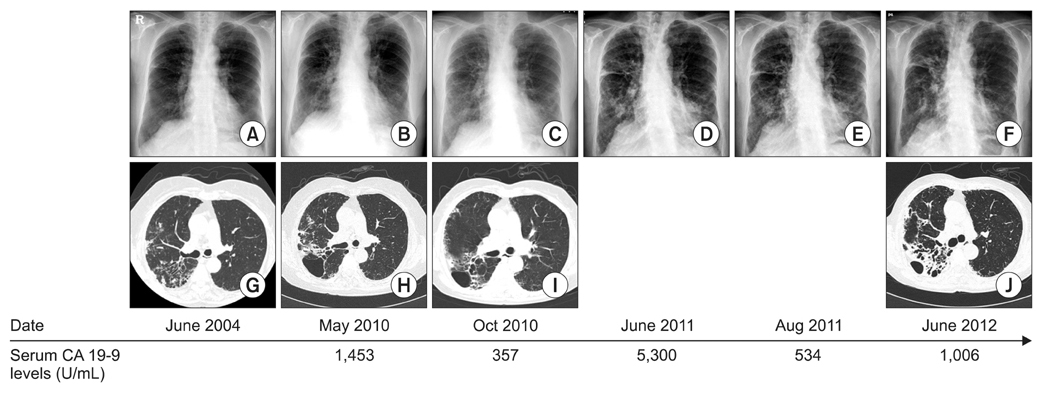Tuberc Respir Dis.
2013 Sep;75(3):125-127.
Extremely Increased Serum Carbohydrate Antigen 19-9 Levels Caused by New or Resistant Infections to Previous Antibiotics in Chronic Lung Diseases
- Affiliations
-
- 1Department of Internal Medicine, Daejeon Veterans Hospital, Daejeon, Korea.
- 2Department of Internal Medicine, Chungnam National University College of Medicine, Daejeon, Korea. vov-x@hanmail.net
Abstract
- In this paper, we describe 72-year-old female patient without evidence of malignant disease presented with significantly elevated serum carbohydrate antigen (CA) 19-9 levels by respiratory infections. She was diagnosed with respiratory infections due to Mycobacterium avium complex and Pseudomonas aeruginosa. The serum CA 19-9 levels remarkably increased (1,453-5,300 U/mL; reference range, <37 U/mL) by respiratory infection and abruptly decreased (357-534 U/mL) whenever infection was controlled by specific treatments. This case suggests that serum CA 19-9 levels may be used as a diagnostic marker to indicate new or resistant infections to previous antibiotics in chronic lung diseases without significant changes in chest X-ray findings.
Keyword
MeSH Terms
Figure
Reference
-
1. Plebani M, Basso D, Panozzo MP, Fogar P, Del Favero G, Naccarato R. Tumor markers in the diagnosis, monitoring and therapy of pancreatic cancer: state of the art. Int J Biol Markers. 1995; 10:189–199.2. Yokoyama T, Ikedou Y, Kido F, Tanoue S, Tashiro K, Ninomiya H, et al. A study of sialylated carbohydrate antigen in patients with benign bronchopulmonary disease. Nihon Kokyuki Gakkai Zasshi. 1998; 36:851–856.3. Matsuoka Y, Endo K, Kawamura Y, Yoshida T, Saga T, Watanabe Y, et al. Normal bronchial mucus contains high levels of cancer-associated antigens, CA125, CA19-9, and carcinoembryonic antigen. Cancer. 1990; 65:506–510.4. Shimizu Y, Hamada T, Tanaka Y, Sasaki A, Nemoto T. Colocalization of CA19-9 and KL-6 to epithelial cells in dilated bronchioles in a patient with idiopathic pulmonary fibrosis complicated by diffuse alveolar damage. Respirology. 2002; 7:281–284.5. Mukae H, Hirota M, Kohno S, Komori K, Fukushima K, Hiratani K, et al. Elevation of tumor-associated carbohydrate antigens in patients with diffuse panbronchiolitis. Am Rev Respir Dis. 1993; 148:744–751.6. Kim HR, Lee CH, Kim YW, Han SK, Shim YS, Yim JJ. Increased CA 19-9 level in patients without malignant disease. Clin Chem Lab Med. 2009; 47:750–754.7. Yamazaki Y, Kubo K, Takamizawa A, Yamamoto H, Honda T, Sone S. Markers indicating deterioration of pulmonary Mycobacterium avium-intracellulare infection. Am J Respir Crit Care Med. 1999; 160:1851–1855.8. Watanabe K, Fujimura M, Kasahara K, Yasui M, Myou S, Watanabe A, et al. Characteristics of pulmonary Mycobacterium avium-intracellulare complex (MAC) infection in comparison with those of tuberculosis. Respir Med. 2003; 97:654–659.9. Kodama T, Satoh H, Ishikawa H, Ohtsuka M. Serum levels of CA19-9 in patients with nonmalignant respiratory diseases. J Clin Lab Anal. 2007; 21:103–106.10. Sheen-Chen SM, Sun CK, Liu YW, Eng HL, Ko SF, Kuo CH. Extremely elevated CA19-9 in acute cholangitis. Dig Dis Sci. 2007; 52:3140–3142.11. Lin CL, Changchien CS, Chen YS. Mirizzi's syndrome with a high CA19-9 level mimicking cholangiocarcinoma. Am J Gastroenterol. 1997; 92:2309–2310.
- Full Text Links
- Actions
-
Cited
- CITED
-
- Close
- Share
- Similar articles
-
- Normalization of Elevated CA 19-9 Level after Treatment in a Patient with the Nodular Bronchiectatic Form of Mycobacterium abscessus Lung Disease
- Elevated Carbohydrate Antigen 19-9 Level in a Patient with Horseshoe Type Pulmonary Sequestration
- Intralobar Pulmonary Sequestration Showing Increased Serum CA19-9
- Clinical Observation on Staphylococcus aureus Bacteremia of Community Hospital
- Therapeutic strategy for the management of multidrug-resistant gram-negative bacterial infections



